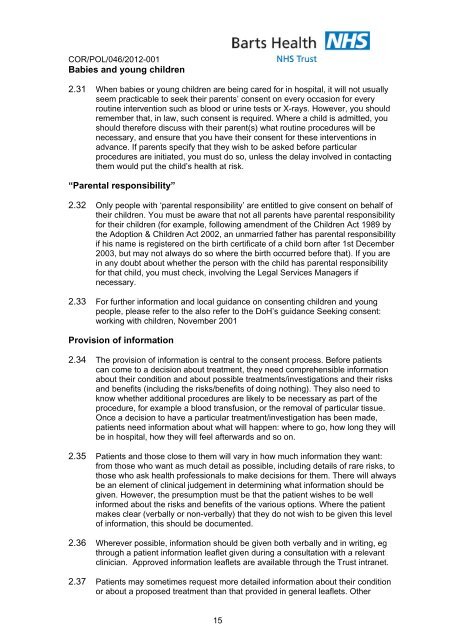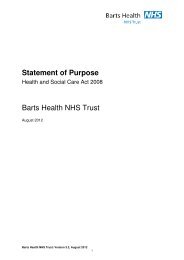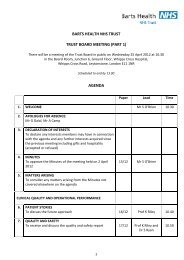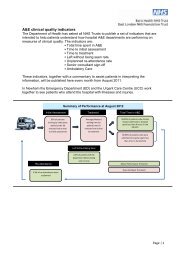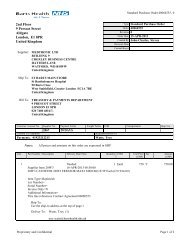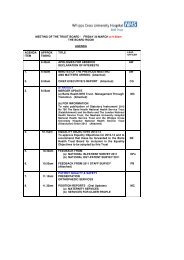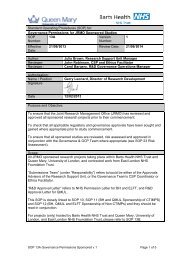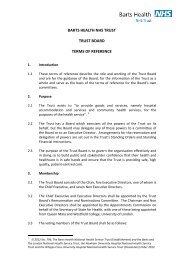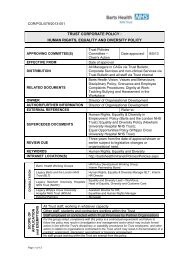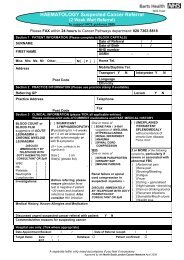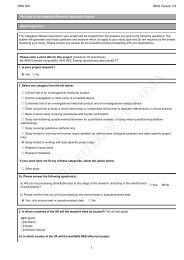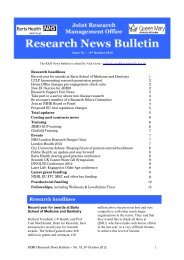Consent to examination and treatment - Barts Health NHS Trust
Consent to examination and treatment - Barts Health NHS Trust
Consent to examination and treatment - Barts Health NHS Trust
You also want an ePaper? Increase the reach of your titles
YUMPU automatically turns print PDFs into web optimized ePapers that Google loves.
COR/POL/046/2012-001<br />
Babies <strong>and</strong> young children<br />
2.31 When babies or young children are being cared for in hospital, it will not usually<br />
seem practicable <strong>to</strong> seek their parents’ consent on every occasion for every<br />
routine intervention such as blood or urine tests or X-rays. However, you should<br />
remember that, in law, such consent is required. Where a child is admitted, you<br />
should therefore discuss with their parent(s) what routine procedures will be<br />
necessary, <strong>and</strong> ensure that you have their consent for these interventions in<br />
advance. If parents specify that they wish <strong>to</strong> be asked before particular<br />
procedures are initiated, you must do so, unless the delay involved in contacting<br />
them would put the child’s health at risk.<br />
“Parental responsibility”<br />
2.32 Only people with ‘parental responsibility’ are entitled <strong>to</strong> give consent on behalf of<br />
their children. You must be aware that not all parents have parental responsibility<br />
for their children (for example, following amendment of the Children Act 1989 by<br />
the Adoption & Children Act 2002, an unmarried father has parental responsibility<br />
if his name is registered on the birth certificate of a child born after 1st December<br />
2003, but may not always do so where the birth occurred before that). If you are<br />
in any doubt about whether the person with the child has parental responsibility<br />
for that child, you must check, involving the Legal Services Managers if<br />
necessary.<br />
2.33 For further information <strong>and</strong> local guidance on consenting children <strong>and</strong> young<br />
people, please refer <strong>to</strong> the also refer <strong>to</strong> the DoH’s guidance Seeking consent:<br />
working with children, November 2001<br />
Provision of information<br />
2.34 The provision of information is central <strong>to</strong> the consent process. Before patients<br />
can come <strong>to</strong> a decision about <strong>treatment</strong>, they need comprehensible information<br />
about their condition <strong>and</strong> about possible <strong>treatment</strong>s/investigations <strong>and</strong> their risks<br />
<strong>and</strong> benefits (including the risks/benefits of doing nothing). They also need <strong>to</strong><br />
know whether additional procedures are likely <strong>to</strong> be necessary as part of the<br />
procedure, for example a blood transfusion, or the removal of particular tissue.<br />
Once a decision <strong>to</strong> have a particular <strong>treatment</strong>/investigation has been made,<br />
patients need information about what will happen: where <strong>to</strong> go, how long they will<br />
be in hospital, how they will feel afterwards <strong>and</strong> so on.<br />
2.35 Patients <strong>and</strong> those close <strong>to</strong> them will vary in how much information they want:<br />
from those who want as much detail as possible, including details of rare risks, <strong>to</strong><br />
those who ask health professionals <strong>to</strong> make decisions for them. There will always<br />
be an element of clinical judgement in determining what information should be<br />
given. However, the presumption must be that the patient wishes <strong>to</strong> be well<br />
informed about the risks <strong>and</strong> benefits of the various options. Where the patient<br />
makes clear (verbally or non-verbally) that they do not wish <strong>to</strong> be given this level<br />
of information, this should be documented.<br />
2.36 Wherever possible, information should be given both verbally <strong>and</strong> in writing, eg<br />
through a patient information leaflet given during a consultation with a relevant<br />
clinician. Approved information leaflets are available through the <strong>Trust</strong> intranet.<br />
2.37 Patients may sometimes request more detailed information about their condition<br />
or about a proposed <strong>treatment</strong> than that provided in general leaflets. Other<br />
15


